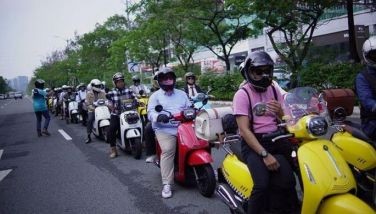Parking lot races, anyone?
March 6, 2002 | 12:00am
 So, there’s really no going back to mere couch racing for you? (Ok, maybe once in a while.) If karting is a bit steep on the pocket or too time-consuming, and you prefer to turn a wheel so drag racing is out of the equation, there’s another, less costly yet safe route to take in the motorsport road trip: Slalom racing.
So, there’s really no going back to mere couch racing for you? (Ok, maybe once in a while.) If karting is a bit steep on the pocket or too time-consuming, and you prefer to turn a wheel so drag racing is out of the equation, there’s another, less costly yet safe route to take in the motorsport road trip: Slalom racing.
Slalom racing is not exactly new to the country. In recent times–12 years to be exact–this form of motorsport have been making the rounds of various parking lots in the metro. Organized by Race Motorsports Club, credit for the longevity of this successful race series largely goes to another hubby-and-wife racing duo, Lito and Bing Bang Dulce (who’re slalom technical director and club president), and the couple’s longtime friend, Oski Nuke, who serves as slalom’s race director. Of course, providing major support for slalom racing is sponsor Shell.
The sport calls for precision driving around a makeshift race course, usually set in parking lots. A competitor’s objective is to drive through the course in the shortest possible time, while avoiding the pylons–which serve as obstacles–that dot the track. Of course, not getting in contact with curbs, lampposts, spectators and the like is equally important. Drivers are classified according to skill and experience, cars according to the level of modifications.
Since races are held on closed-off parking areas or any expanse of flat, concrete space, and the fact that it is a race to beat the clock only (which means no wheel-to-wheel racing), slalom racing is quite safe.
"In fact, it is the safest form of racing," said Nuke. "Speeds rarely exceed 90 kph, because it is limited by the configuration of the track. Also, spectators are not allowed on areas where cars may run the risk of going off the course." In all the years, there were no injuries more serious than minor wounds, asserted Nuke. Or bruised egos.
Because of that, competitors are not particularly required to purchase race-legal helmets, or don pricey race suits, gloves, shoes or whatever else any Montoya wannabe fancies to wear. Cars go through a strict scrutineering process, which mainly involves determining a car’s safety and roadworthiness, and to check if everything is within the restrictions of a certain class. No lightening allowed in the "stock’ class, for instance. As a rule, not all cars are required to be equipped with rollcages, bucket seats and the like.
The faster, modified cars and the more proficient drivers have to have certain equipment, the level of which corresponds to the class type they’re competing in. Generally speaking, though, it’s come as you are and run what you "brung".
Which make slalom racing inexpensive, said Nuke. "Anybody can bring a car and simply find the class they can compete in. It doesn’t have to be a race car, even cars one drive to the office can be used."
Being safe and inexpensive means a high turnout of participants every race day. Which also means close competition and spectacular races. Make no mistake, even if racing speeds are relatively low, things get busy when you’re doing 80 or even just 70 kph at the end of a straight when that straight is in a parking lot. One has to thread his (or her, there is a ladies’ class, but women can compete in any class too) through the tight, twisty course avoiding various obstacles, perform a 180-degree turn and a crowd-wowing 360-degree controlled spin. All done while most cars, especially the more potent ones, are slipping and sliding every which way. Also, since most courses are traversed in about 50 to 60 seconds, winning times are mostly decided by just fractions of a second. Exciting does not begin to describe it.
A big factor in slalom’s popularity as well is its accessibility. With 17 races scheduled this year, there is one every month, sometimes two – more races than any other motorsport discipline in the country can offer. This number guarantees more chances for people to join in slalom events. Add to that the fact that the series is held in shopping mall parking lots across the Metro and nearby provinces. Not surprisingly, around 70 drivers and 40 to 50 cars show up on any race day, making up a total of about 120 entries in all classes combined.
Through the years, slalom has produced its fair share of race drivers that has become stars in other motorsports. "Slalom offers the best racing experience and training for beginners," said Nuke. "In slalom, one can sharpen his driving skill, improve focus and concentration, and get a taste of real competition. Plus, one can also learn the rudiments of car tuning and preparation."
Combine slalom racing’s low costs, safety, accessibility – and above all – excitement that it offers, and we have what may be the best excuse to drive fast around a parking lot. Which is a whole lot better than racing on the streets.
(For interested parking lot racer aspirants, call Lito or Bing Bang Dulce at 928-6951, 920-6356 or 0917-8119337 for more details.)
BrandSpace Articles
<
>
- Latest
Latest
Latest
September 30, 2024 - 4:26pm
By EC Toledo | September 30, 2024 - 4:26pm
September 26, 2024 - 3:30pm
September 26, 2024 - 3:30pm
August 16, 2024 - 11:00am
By Euden Valdez | August 16, 2024 - 11:00am
Recommended






























